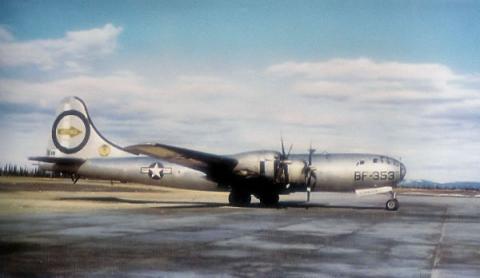Hio all
Been considering an idea on the following situation. Since I'm not very good at writing drama, I'm post it as a theory.
So here it goes. It's the US, July 1944. The Manhattan project is in full swing, everything going as in OTL. Problems, ideas, solutions, etc. "We'll get there, we'll get it done". The major problem is the delivery platform, and here things were most definetly not going as planned. The programm had been pilling up problems after problems, and now it was almost dead. General Hap Arnold's best atempt to fix the problems of the dozens built so far, a major all out effort, had ended in the disaster that would be called "The massacre of Kansas", when a B-29 on a test flight crashed straight into the Wichitta plant. The combination of aviation fuel, strong wings and the sheer size of the area culminated in the destruction of most of the plant and the deaths of hundreds of skilled workers and engineers, including most of the programm's senior staff, gathered at the factory to focus on the issues. A shocked Boeing was still trying to recover and had yet delivered it's final report, but sources in the company had told the USAAF that there was no way to recover before late 1945, early 1946. At best.
The USAAF is now faced with having to turn to the "fall back" option, the B-32. But that programm too is also seriously delayed, with only a few flying. And then someone (no one ever admited who) said "What about the brit Lancaster?" and everyone in the room stared.
"What?"
"Yes, the Lancaster. They've been dropping 12.000 pound bombs, and we know they are building a bigger one. Could that plane be used by us?"
"The USAAF flying a foreign bomber? For such a top secret mission?!"
"Well... what choice to we have? Want to wait untill 1946?"
And silence fell in the room.
So... there you have it. If the USAAF wanted to keep setting it's sights on a 1945 drop, and both the B-29 and B-32 were out, could the Lancaster do it? In terms of bomb weight and size, I say yes. Both 1945 nukes were light and smaller than Grand Slam (specially Little Boy), so it's a matter of fitting. My concerns are range and altitude. Range might be solved by launching from Okinawa (plenty of time to make longer runways there) but altiture is another matter. With such a light bomb, it would able to fly higher than Grand Slam missions, but I have no idea if it would fly high enough, or how low these nukes could be dropped from. Thoughts?
Been considering an idea on the following situation. Since I'm not very good at writing drama, I'm post it as a theory.
So here it goes. It's the US, July 1944. The Manhattan project is in full swing, everything going as in OTL. Problems, ideas, solutions, etc. "We'll get there, we'll get it done". The major problem is the delivery platform, and here things were most definetly not going as planned. The programm had been pilling up problems after problems, and now it was almost dead. General Hap Arnold's best atempt to fix the problems of the dozens built so far, a major all out effort, had ended in the disaster that would be called "The massacre of Kansas", when a B-29 on a test flight crashed straight into the Wichitta plant. The combination of aviation fuel, strong wings and the sheer size of the area culminated in the destruction of most of the plant and the deaths of hundreds of skilled workers and engineers, including most of the programm's senior staff, gathered at the factory to focus on the issues. A shocked Boeing was still trying to recover and had yet delivered it's final report, but sources in the company had told the USAAF that there was no way to recover before late 1945, early 1946. At best.
The USAAF is now faced with having to turn to the "fall back" option, the B-32. But that programm too is also seriously delayed, with only a few flying. And then someone (no one ever admited who) said "What about the brit Lancaster?" and everyone in the room stared.
"What?"
"Yes, the Lancaster. They've been dropping 12.000 pound bombs, and we know they are building a bigger one. Could that plane be used by us?"
"The USAAF flying a foreign bomber? For such a top secret mission?!"
"Well... what choice to we have? Want to wait untill 1946?"
And silence fell in the room.
So... there you have it. If the USAAF wanted to keep setting it's sights on a 1945 drop, and both the B-29 and B-32 were out, could the Lancaster do it? In terms of bomb weight and size, I say yes. Both 1945 nukes were light and smaller than Grand Slam (specially Little Boy), so it's a matter of fitting. My concerns are range and altitude. Range might be solved by launching from Okinawa (plenty of time to make longer runways there) but altiture is another matter. With such a light bomb, it would able to fly higher than Grand Slam missions, but I have no idea if it would fly high enough, or how low these nukes could be dropped from. Thoughts?

